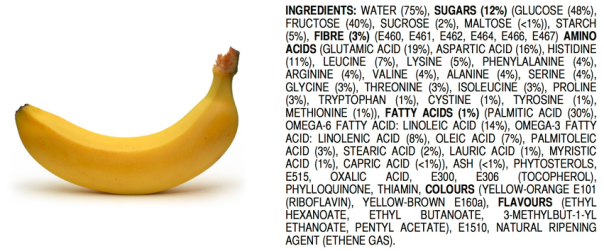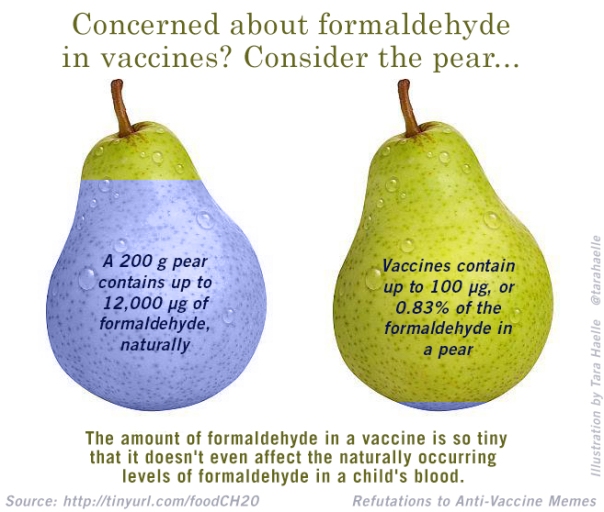
What is chemophobia?
The scientific community describes chemophobia as a “non-clinical prejudice” – rather like homophobia or xenophobia – that is, not a true medical phobia but a learned aversion to ingredients created in laboratories. Researchers Paul Slovic and Baruch Fischhoff identified a number of affective characteristics that help to explain deep and persistent overestimation of chemical risk. They found that people tend to overestimate human-made risks, and underestimate natural risks.
On Artificial Formaldehyde
The most dangerous consequence of this quirk is people’s fear of formaldehyde. Formaldehyde is a naturally-occurring compound that is found in fruits such as peaches and pears, vegetables, meat, eggs and foliage, and is found in very high concentrations in Peking duck, smoked salmon and processed meats (e.g. ham and sausages). These so-called ‘natural’ sources of formaldehyde are usually considered acceptable by the public, while artificial sources of formaldehyde such as vaccines and baby shampoo, have caused public outcry.
“People tend to overestimate human-made risks, and underestimate natural risks.” – Slovic & Fischhoff
One such outcry forced Johnson’s to undertake one of the biggest reformulations in history, and remove all traces of formaldehyde from its products. This was despite the fact that there was so little formaldehyde present in their baby shampoo that you’d need to take 40 million baths per day to reach dangerous levels. Johnson’s spent tens of millions of dollars on a reformulation project not because they were legally obliged to, and not because there was ever a safety risk, but because they were under pressure from irrational consumers to change their recipe. I call them irrational because nobody ever petitioned for an expensive reformulation of smoked salmon, Peking duck, peaches or pears because of formaldehyde fears.
Vaccines also contain tiny amounts of formaldehyde. Irrational fear of ‘artificial’ formaldehyde has led some people to avoid vaccinations altogether even though the level of formaldehyde found in a vaccine is 80 times less than in a single pear. People’s irrational fear of formaldehyde has caused many preventable deaths; anti-vaccination movements have caused measles outbreaks in California (2015), Germany (2015), Wales (2013) and other places.

People overestimate risks that are imposed on us, like contaminants and pollutants, than risks we engage in voluntarily
Another reason people fear formaldehyde in vaccines (but not in pears) is because humans are irrationally hard-wired to overestimate the magnitude of risks that are imposed upon us. Most people over-fear terrorism and under-fear obesity. Terrorism killed 32,000 people in 2015, yet obesity kills tens of millions of people each year. Despite that, terrorism remains a key subject in American presidential debates because people’s fear of terrorism is inflated out of proportion by the fact that it’s imposed on the public rather than being caused by the public themselves. Americans are 33,000 times more likely to die from a heart-related disease than from terrorism, yet terrorism tops people’s list of fears due to the irrational quirks of human risk perception.
We all are born with these afflictions, and only science education can help us overcome them
The psychology behind these irrational assumptions is innate and is present in all of us. It’s only with science education and a basic knowledge of toxicology that we can begin to assess the risks associated with different compounds in a meaningful way. Only science education can fight chemophobia and allow people to make rational decisions about healthcare, skincare and nutrition.
This post is part 5 in a weekly series about chemophobia. Not only are people less afraid of natural toxins than synthetic ones, but in some cases, safety legislation is more lenient when it comes to natural threats vs artificial ones. Next week, we’ll explore some specific examples of toxins that are present (naturally and artificially) in the foods we eat.
I’ve found this citation very interesting:
“…alcohol, caffeine and caspaicin (in chillies) top the list of most dangerous compounds we ingest on a day-to-day basis. The toxicity of pesticides in a typical western diet is of negligible significance when compared with those three toxins”
I’d like to read the whole article, but I cannot google it. Could you share us the source of it in an update?
Thank you!
LikeLike
I knew salsa would be the death of me! 🙂
LikeLike
I really love all the articles on chemophobia, they are very enlighting. I reckon the fuss over the formaldehyde in cosmetics is similar to the one about parabens. That’s really ridiculous.
Greetings from Poland!
LikeLiked by 1 person
Yes… parabens also received terrible press. It’s interesting how people’s perception of risk shows no correlation with actual risk level. This has been documented in many studies.
LikeLike
I found a fantastic piece of furniture at a great price. I was just about to purchase it when I saw a label that read “California phase two compliant for formaldahyde”. Is this level of formaldehyde something I should worry about or too low to let myself get caught up in chemophobia? Thx
LikeLike